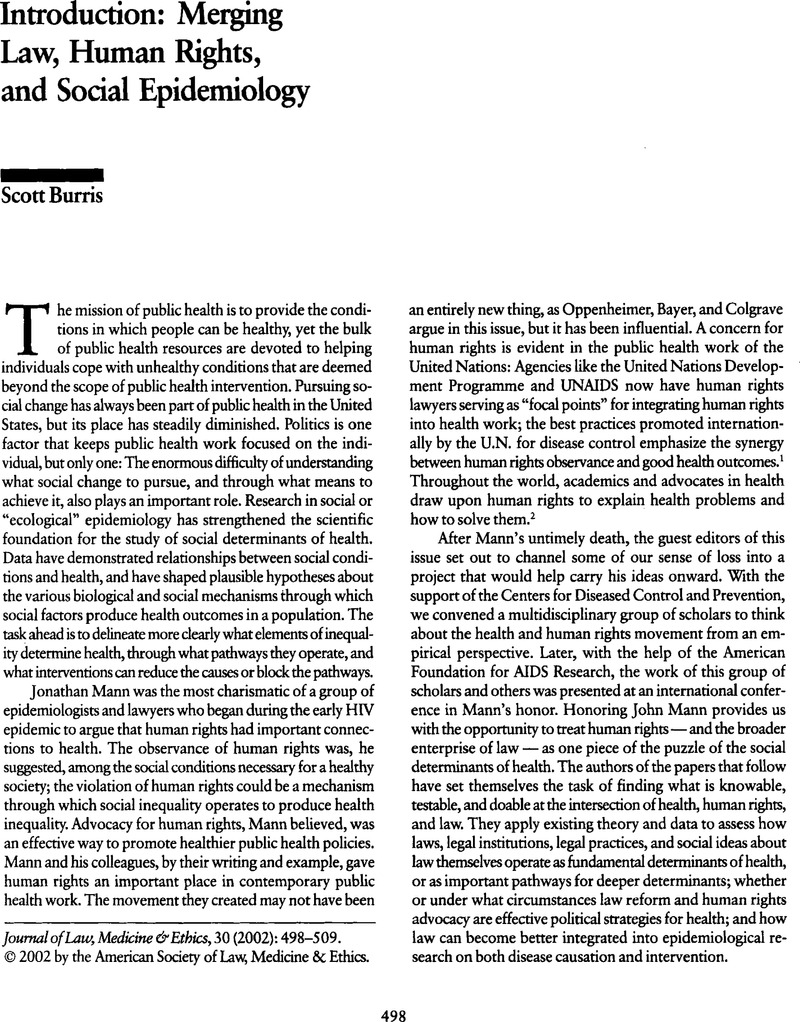Crossref Citations
This article has been cited by the following publications. This list is generated based on data provided by Crossref.
Marks, Stephen P.
2002.
The Evolving Field of Health and Human Rights: Issues and Methods.
Journal of Law, Medicine & Ethics,
Vol. 30,
Issue. 4,
p.
739.
Jacobson, Peter D.
and
Soliman, Soheil
2002.
Co-Opting the Health and Human Rights Movement.
Journal of Law, Medicine & Ethics,
Vol. 30,
Issue. 4,
p.
705.
Burris, Scott
Kawachi, Ichiro
and
Sarat, Austin
2002.
Integrating Law and Social Epidemiology.
Journal of Law, Medicine & Ethics,
Vol. 30,
Issue. 4,
p.
510.
Lazzarini, Zita
and
Klitzman, Robert
2002.
HIV and the Law: Integrating Law, Policy, and Social Epidemiology.
Journal of Law, Medicine & Ethics,
Vol. 30,
Issue. 4,
p.
533.
Jacoby, Melissa B.
2002.
Does Indebtedness Influence Health? A Preliminary Inquiry.
Journal of Law, Medicine & Ethics,
Vol. 30,
Issue. 4,
p.
560.
BURRIS, SCOTT
BLANKENSHIP, KIM M.
DONOGHOE, MARTIN
SHERMAN, SUSAN
VERNICK, JON S.
CASE, PATRICIA
LAZZARINI, ZITA
and
KOESTER, STEPHEN
2004.
Addressing the “Risk Environment” for Injection Drug Users: The Mysterious Case of the Missing Cop.
The Milbank Quarterly,
Vol. 82,
Issue. 1,
p.
125.
Sato, Hajime
2005.
Public Health Policy and Human Rights.
Iryo To Shakai,
Vol. 15,
Issue. 2,
p.
63.
Reynolds, C.
2008.
International Encyclopedia of Public Health.
p.
45.
Burris, Scott
and
Xia, Guomei
2009.
Gender Policy and HIV in China.
Vol. 22,
Issue. ,
p.
179.
Johnston, Vanessa
Allotey, Pascale
Mulholland, Kim
and
Markovic, Milica
2009.
Measuring the health impact of human rights violations related to Australian asylum policies and practices: a mixed methods study.
BMC International Health and Human Rights,
Vol. 9,
Issue. 1,
Wood, Jennifer
Swanson, Jeffrey W.
Burris, Scott C.
and
Gilbert, Allison
2011.
Monograph: 'Police Interventions with Persons Affected by Mental Illnesses'.
SSRN Electronic Journal,
Mpinga, Emmanuel Kabengele
London, Leslie
and
Chastonay, Philippe
2011.
Health and human rights: epistemological status and perspectives of development.
Medicine, Health Care and Philosophy,
Vol. 14,
Issue. 3,
p.
237.
Dickson-Gomez, Julia
McAuliffe, Timothy
Rivas de Mendoza, Lorena
Glasman, Laura
and
Gaborit, Mauricio
2012.
The Relationship Between Community Structural Characteristics, the Context of Crack Use, and HIV Risk Behaviors in San Salvador, El Salvador.
Substance Use & Misuse,
Vol. 47,
Issue. 3,
p.
265.
Burris, Scott
and
Koester, Stephen
2013.
Investigating the Intersection of Policing and Public Health.
PLoS Medicine,
Vol. 10,
Issue. 12,
p.
e1001571.
Mitchell, Jamie A.
2013.
Social Epidemiology: A Tool for Examining Prostate Cancer Early-Detection Decision Making among Older African American Men.
Social Work in Public Health,
Vol. 28,
Issue. 7,
p.
652.





